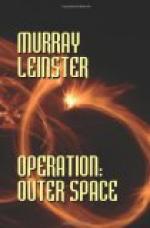“Cut,” said Cochrane.
West automatically abandoned his professional delivery. He placidly re-addressed himself to his beer.
“How about it, Jones?” asked Cochrane. “Dabney’s got a variation? What is it?”
“It’s a field of force that doesn’t spread out. You set up two plates and establish this field between them,” said Jones curtly. “It’s circularly polarized and it doesn’t expand. It’s like a searchlight beam or a microwave beam, and it stays the same size like a pipe. In that field—or pipe—radiation travels faster than it does outside. The properties of space are changed between the plates. Therefore the speed of all radiation. That’s all.”
Cochrane meditatively seated himself. He approved of this Jones, whose eyebrows practically met in the middle of his forehead. He was not more polite than politeness required. He did not express employer-like rapture at the mention of his employer’s name.
“But what can be done with it?” asked Cochrane practically.
“Nothing,” said Jones succinctly. “It changes the properties of space, but that’s all. Can you think of any use for a faster-than-light radiation-pipe? I can’t.”
Cochrane cocked an eye at Jamison, who could extrapolate at the drop of an equation. But Jamison shook his head.
“Communication between planets,” he said morosely, “when we get to them. Chats between sweethearts on Earth and Pluto. Broadcasts to the stars when we find that another one’s set up a similar plate and is ready to chat with us. There’s nothing else.”
Cochrane waved his hand. It is good policy to put a specialist in his place, occasionally.
“Demonstration?” he asked Jones.
“There are plates across the crater out yonder,” said Jones without emotion. “Twenty miles clear reach. I can send a message across and get it relayed twice and back through two angles in about five per cent of the time radiation ought to take.”
Cochrane said with benign cynicism:
“Jamison, you work by guessing where you can go. Jones works by guessing where he is. But this is a public relations job. I don’t know where we are or where we can go, but I know where we want to take this thing.”
Jones looked at him. Not hostilely, but with the detached interest of a man accustomed to nearly exact science, when he watches somebody work in one of the least precise of them all.
Holden said:
“You mean you’ve worked out some sort of production.”
“No production,” said Cochrane blandly. “It isn’t necessary. A straight public-relations set-up. We concoct a story and then let it leak out. We make it so good that even the people who don’t believe it can’t help spreading it.” He nodded at Jamison. “Right now, Jamison, we want a theory that the sending of radiation at twenty times the speed of light means that there is a way to send matter faster than light—as




